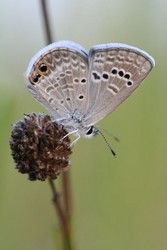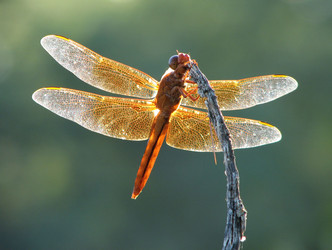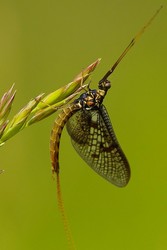Pterygota
Winged insects



This tree diagram shows the relationships between several groups of organisms.
The root of the current tree connects the organisms featured in this tree to their containing group and the rest of the Tree of Life. The basal branching point in the tree represents the ancestor of the other groups in the tree. This ancestor diversified over time into several descendent subgroups, which are represented as internal nodes and terminal taxa to the right.

You can click on the root to travel down the Tree of Life all the way to the root of all Life, and you can click on the names of descendent subgroups to travel up the Tree of Life all the way to individual species.
For more information on ToL tree formatting, please see Interpreting the Tree or Classification. To learn more about phylogenetic trees, please visit our Phylogenetic Biology pages.
close boxIntroduction
Insects were the first organisms on Earth to evolve active flight. It is likely that the ability to fly arose only once in insects, over 300 million years ago in the Carboniferous period. About 70 million years later active flight arose within vertebrates (pterosaurs), followed by separate origins in birds and bats.
Winged insects, or pterygotes, have radiated into over 100 times more species than all of the winged vertebrate lineages combined. They include all of the commonly encountered insects; the most common non-pterygote insect lineage are the Thysanura (silverfish and firebrats).
Many groups of insects have subsequently lost the ability to fly. Some of these (lice and fleas, for example) have lost all remnants of wings. It is only through their evident relationship with particular groups of winged insects (lice are closely related to psocids [book lice]; fleas are related to flies) that it is clear that their ancestors had wings.
Characteristics
The primary derived characteristic of pterygotes is the presence of veined wings on the second (meso-) and third (meta-) thoracic segment.
Paleopterous and neopterous insects
Two groups of pterygotes evolved the ability to fold their wings back flat against their abdomens. The largest of these is the clade Neoptera ("new wing"). Remaining insects (all of the taxa in the above tree except for Neoptera) are sometimes referred to as Paleoptera ("old wing"), because they lack the sophisticated wing-folding mechanism of neopterous insects. Members of paleopterous insects cannot fold their wings back over their abdomens, with the exception of the extinct order Diaphonopterodea, which could fold their wings using a mechanism different than Neoptera. (Some neopterous insects, such as butterflies, can no longer fold their wings against their abdomen, but this clearly represents a secondary loss.)
Discussion of Phylogenetic Relationships
While the relationships of the extinct paleodictyopteroid orders (Diaphanopterodea, Paleodictyoptera, Megasecoptera, and Permothemistida) to each other and to other orders have not been extensively examined, the relationships of the three living lineages (Ephemeroptera, Odonata, and Neoptera) to each other have been the subject of much debate. Each of the three possible relationships are supported by various authors.
A monophyletic Paleoptera was advocated by Hennig (1969, 1981) and Hovmöller et al. (2002):
=== Odonata
==Paleoptera=|
=====| === Ephemeroptera
|
================ Neoptera
Boudreaux (1979) favored monophyly of Ephemeroptera + Neoptera:
====== Odonata
|
=====| === Ephemeroptera
===|
=== Neoptera
Kristensen (1975, 1981, 1991) and Wheeler et al. (2001) present evidence in support of monophyly of Odonata + Neoptera:
====== Ephemeroptera
|
=====| === Odonata
===|
=== Neoptera
References
Averof, M. and S. M. Cohen. 1997. Evolutionary origin of insect wings from ancestral gills. Nature 385:627-630.
Boudreaux, H. B. 1979. Arthropod Phylogeny with Special Reference to Insects. New York, J. Wiley.
Carpenter, F .M. 1992. Superclass Hexapoda. Volumes 3 and 4 of Part R, Arthropoda 4 of Treatise on Invertebrate Paleontology. Boulder, Colorado, Geological Society of America.
Dickinson, M. H., S. Hannaford, and J. Palka. 1997. The evolution of insect wings and their sensory apparatus. Brain Behavior And Evolution 50:13-24.
Dudley, R. 2000. The evolutionary physiology of animal flight: Paleobiological and present perspectives. Annual Review of Physiology 62:135-155.
Grimaldi, D. 2001. Insect evolutionary history from Handlirsch to Hennig, and beyond. Journal of Paleontology 75:1152-1160.
Hasenfuss, I. 2002. A possible evolutionary pathway to insect flight starting from lepismatid organization. Journal of Zoological Systematics and Evolutionary Research 40(2):65-81.
Hennig, W. 1981. Insect Phylogeny. New York, J. Wiley.
Hovmöller, R., T. Pape, and M. Källersjö. 2002. The Palaeoptera problem: Basal pterygote phylogeny inferred from 18S and 28S rDNA Sequences. Cladistics 18:313-323.
Kingsolver, J. G. and M. A. R. Koehl. 1994. Selective factors in the evolution of insect wings. Annual Review of Entomology 39:425-451.
Kjer, K. M. 2004. Aligned 18S and insect phylogeny. Systematic Biology 53(3):506-514.
Klass, K. D. 1998. The proventriculus of the Dicondylia, with comments on evolution and phylogeny in Dictyoptera and Odonata (Insecta). Zoologischer Anzeiger 237(1):15-42.
Kristensen, N. P. 1975. The phylogeny of hexapod "orders". A critical review of recent accounts. Zeitschrift für zoologische Systematik und Evolutionsforschung 13:1–44.
Kristensen, N. P. 1991. Phylogeny of extant arthropods. Pages 125-140 in Insects of Australia: A Textbook for Students and Research Workers. Volume I. Second Edition. I. D. Naumann, P. B. Carne, J. F. Lawrence, E. S. Nielsen, J. P. Spradberry, R. W. Taylor, M. J. Whitten and M. J. Littlejohn eds. Carlton, Victoria, Melbourne University Press.
Kukalová-Peck, J. 1983. Origin of insect wing and wing articulation from the insect leg. Canadian Journal of Zoology 61:1618–1669.
Kukalová-Peck, J. and C. Braukmann. 1990. Wing folding in pterygote insects, and the oldest Diaphanopterodea from the early Late Carbonferous of West Germany. Canadian Journal of Zoology 68:1104-1111.
Marden, J. H., B. C. O'Donnell, M. A. Thomas, and J. Y. Bye. 2000. Surface-skimming stoneflies and mayflies: The taxonomic and mechanical diversity of two-dimensional aerodynamic locomotion. Physiological and Biochemical Zoology 73(6):751-764.
Marden, J. H. and M. G. Kramer. 1994. Surface-skimming stoneflies - a possible intermediate stage in insect flight evolution. Science 266(5184):427-430.
Merritt, R. W. and K. W.Cummins, eds. 1984. An Introduction to the Aquatic Insects of North America, Second Edition. Kendall-Hunt.
Naumann, I. D., P. B. Carne, J. F. Lawrence, E. S. Nielsen, J. P. Spradberry, R. W. Taylor, M. J. Whitten and M. J. Littlejohn, eds. 1991. The Insects of Australia: A Textbook for Students and Research Workers. Volume I and II. Second Edition. Carlton, Victoria, Melbourne University Press.
Ogden, T. H. and M. F. Whiting. 2003. The problem with "the Paleoptera Problem:" sense and sensitivity. Cladistics 19(5):432-442.
Taylor, G. K. 2001. Mechanics and aerodynamics of insect flight control. Biological Reviews of the Cambridge Philosophical Society 76(4):449-471.
Wheeler, W. C., M. Whiting, Q. D. Wheeler, and J. M. Carpenter. 2001. The phylogeny of the extant hexapod orders. Cladistics 17:113-169.
Will, K. W. 1995. Plecopteran surface-skimming and insect flight evolution. Science 270(5242):1684-1685.
Wootton, R. J. 1988. The historical Ecology of aquatic insects - an overview. Palaeogeography, Palaeoclimatology, Palaeoecology 62(1-4):477-492.
Wootton, R. J. 1992. Functional morphology of insect wings. Annual Review of Entomology 37:113-140.
Wootton, R. J. and C. R. Betts. 1986. Homology and function in the wings of Heteroptera. Systematic Entomology 11(3):389-400.
Wootton, R. J. and J. Kukalová-Peck. 2000. Flight adaptations in Palaeozoic Palaeoptera (Insecta). Biological Reviews of the Cambridge Philosophical Society 75(1):129-167.
Title Illustrations

| Scientific Name | Echinargus isola |
|---|---|
| Location | Hitchcock Nature Center, Pottawattamie County, Iowa |
| Specimen Condition | Live Specimen |
| Source | Reakirt's Blue |
| Source Collection | Flickr |
| Image Use |
 This media file is licensed under the Creative Commons Attribution-NonCommercial-NoDerivs License - Version 2.0. This media file is licensed under the Creative Commons Attribution-NonCommercial-NoDerivs License - Version 2.0.
|
| Copyright | © 2007 Brian Peterson |
| Scientific Name | Libellula saturata |
|---|---|
| Location | Arroyo Chico, Tucson, Pima County, Arizona, USA |
| Specimen Condition | Live Specimen |
| Source | Flame Skimmer |
| Source Collection | Flickr |
| Image Use |
 This media file is licensed under the Creative Commons Attribution-NonCommercial License - Version 2.5. This media file is licensed under the Creative Commons Attribution-NonCommercial License - Version 2.5.
|
| Copyright |
© 2007

|
| Scientific Name | Ephemera danica |
|---|---|
| Location | Switzerland |
| Specimen Condition | Live Specimen |
| Source | Ephemera danica |
| Source Collection | Flickr |
| Image Use |
 This media file is licensed under the Creative Commons Attribution-NonCommercial-ShareAlike License - Version 2.0. This media file is licensed under the Creative Commons Attribution-NonCommercial-ShareAlike License - Version 2.0.
|
| Copyright | © 2008 Luciano Giussani |
About This Page
Page copyright © 2002 David R. Maddison
 Page: Tree of Life
Pterygota. Winged insects.
The TEXT of this page is licensed under the
Creative Commons Attribution License - Version 3.0. Note that images and other media
featured on this page are each governed by their own license, and they may or may not be available
for reuse. Click on an image or a media link to access the media data window, which provides the
relevant licensing information. For the general terms and conditions of ToL material reuse and
redistribution, please see the Tree of Life Copyright
Policies.
Page: Tree of Life
Pterygota. Winged insects.
The TEXT of this page is licensed under the
Creative Commons Attribution License - Version 3.0. Note that images and other media
featured on this page are each governed by their own license, and they may or may not be available
for reuse. Click on an image or a media link to access the media data window, which provides the
relevant licensing information. For the general terms and conditions of ToL material reuse and
redistribution, please see the Tree of Life Copyright
Policies.
Citing this page:
Tree of Life Web Project. 2002. Pterygota. Winged insects. Version 01 January 2002 (under construction). http://tolweb.org/Pterygota/8210/2002.01.01 in The Tree of Life Web Project, http://tolweb.org/











 Go to quick links
Go to quick search
Go to navigation for this section of the ToL site
Go to detailed links for the ToL site
Go to quick links
Go to quick search
Go to navigation for this section of the ToL site
Go to detailed links for the ToL site